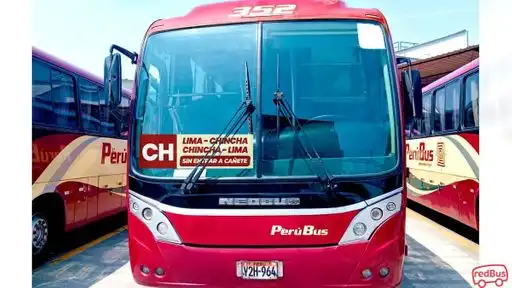Pisco to Lima Bus
OUR PROMISE
SECURE PAYMENT
redBus has secure payments and keeps your information and purchases completely safe and secure.
ATTRACTIVE DEALS
Get amazing discounts every time you book with redBus
WIDE CHOICE OF BUSES
150+ Bus companies with 800+ Routes in Perú
Pisco to Lima Bus Service
Avg. Bus Duration
:3 hrs 59 mins
Buses depart from
:Pisco
Bus arrives in
:Lima
Cheapest Bus
:PEN 20.00
Bus Companies
:3
Earliest Bus
:02:00
Last Bus
:22:55
Daily Bus Services
:37
Pisco to Lima Bus Timings & Fare
| Bus Operator | First Bus | Last Bus | Duration | |
|---|---|---|---|---|
| Perubus | First Bus - 02:25 | Last Bus - 21:55 | 3 hrs 50 mins | VIEW PRICE |
| Jaksa | First Bus - 02:00 | Last Bus - 21:10 | 4 hrs 0 mins | VIEW PRICE |
Buy Pisco to Lima Bus Tickets Online - Unlock Extra Savings with redDeals on redBus
Top Bus Operator Images





Pisco to Lima Bus
OTHER BOARDING & DROPPING POINTS IN
Pisco
- Cruce Pisco
- Pisco
- Terminal Pisco
Lima
- La Victoria
Why book a Pisco to Lima bus with redBus?
You can also time-to-time redBus offers while booking your bus tickets online from Pisco to Lima. Follow a simple, fast and secure bus booking procedure. This helps save time and also helps to create a joyful travel experience!
About Pisco
About Lima
"The City of Kings", as Lima is known, was founded in 1535 by Francisco Pizarro and became the center of Spanish power in Peru, during the colonial period.The urban planning of Lima is one of the colonial models in South America. Lima is known for its social, economical and cultural growth and stands out as the cultural center of Latin America; besides that, Lima is the home of San Marcos National University, the most ancient from America, founded in 1551.Lima is famous for being the viceroyalty capital of Peru and one of the cities most important of South America in the spanish regime period; after its independance in 1821 the city became the republic's capital. Before this period, the Baroque and Neoclassical style took the power on the streets, impregnating those architectural styles in the main constructions. The capital counts a high variety of tourist attractions that combine history and modernity, as you can see on the Historical Center. Another strong point of Lima is the food, there are many restaurants from the 3 Peruvian regions where you can live a complete gastronomical experience, given that the population is multicultural and mostly migrant. Live Peru from one of its corners, and enjoy tasting the culture that Peru offers you!
Lima Weather
The climate in Lima is mild, perfect if you want to spend a few days of total relaxation without too much sun or too much cold. In this city, it is said that only summer and winter can be distinguished, since during the other seasons the climate remains almost the same. During the summer, which is from January to mid-March, the temperature can reach up to 27°C and the sun can be at its peak. In winter, however, it drops to 14°C.
Hotels in Lima
● Selina Miraflores Lima
- C. Alcanfores 465, Miraflores, Lima, Peru.
- Price: From USD $9
- Services: Offers shared and private bedrooms. Wi-fi. Hot Water. Breakfast is available.
● Black Llama Hostel
- C. Berlín 259, Miraflores, Lima, Peru.
- Price: From PEN S/.39.00
- Services: Offers shared and private bedrooms. Wi-fi. Laundry. Includes a free drink.
● Sheraton Lima
- Av. P.º de la Republica 170, Lima, Lima, Peru.
- Price: From PEN S/.299.00
- Services: Offers single, double and quad rooms. Bar. Restaurant. Air conditioning. Lift. Wi-fi.
Restaurants & Bars in Lima
● El Infusionista
- C. Manuel Bonilla 123, Miraflores, Lima, Peru.
- Price: From PEN S/.18.00
● La Cuadra de Salvador
- C. Santa Luisa 265, San Isidro, Lima, Peru.
- Price: From PEN S/.42.00
● La Basilica 640
- Av. Primavera 640, Santiago de Surco, Lima, Peru.
- Price: From PEN S/.58.00
Tourist Places in Lima
● Larco Museum: Ancient mansion converted into a museum, which contains erotic and pre columbian art. Also, it has its own restaurant.
● Magic Water Circuit: Ideal to have a great time, this place provides led light shows.
● Bridge of Sighs: Iconic 1876 wooden bridge, which offers history and myths.
Important Dates in Lima
● October - During this season, known as the "purple month", people organize processions for "The Lord of Miracles".
● October 31st - The "Día de la Canción Criolla" is a peruvian festivity. The event is celebrated with typical food and music.
How to move around Lima?
● Taxi: Taxis can be requested on an app or in the middle of the street, and the driver will tell you the price before you get the service.
● Bus: Buses have their own route, depending on each one, and they are able to take during the entire day.
● Scooter: Ideal to have fun while travelling. The price is based on the time you spend riding it.
Gastronomy in Lima:
Dishes that are a must-have:
● Causa a la Limeña
● Lomo Saltado
● Suspiro a la Limeña
Things to buy in Lima:
Things you can buy in Lima to not forget your trip:
● Pisco
● Silversmith
● Sheets
Lima Facts:
Lima is the capital city of Peru. It contains a population of more than 10 million. This beautiul city is next to the Pacific ocean, and was founded on 18 January 1535.
In conclusion:
Lima has truly delicious food and history you have to discover. Don't forget to visit it!
Hoteles en Lima
Hoteles en Lima
Restaurantes y Bares en Lima
Restaurantes y Bares en Lima
Lugares turísticos en Lima
Lugares turísticos en Lima
Fechas importantes de Lima
Fechas importantes de Lima
¿Cómo moverse por Lima?
Para moverse en la ciudad de Lima, el turista cuenta con 2 opciones: bus público, comúnmente regulado por la municipalidad o autoridad encargada, o taxi, manejado por un ciudadano que presta un servicio.
● Bús público: Es la forma más popular de transportarse dentro de la ciudad, además de ser muy económica. La tarifa, también llamada pasaje, no suele subir de los S/5 por persona. El bus público cuenta con diferentes paraderos en donde recoge pasajeros, por lo que el viaje puede ser un poco lento.
● Taxi: Esta es la manera más rápida de transporte dentro de la ciudad. No cuenta con paraderos, por lo que va de frente hasta el destino deseado. Puede ser contactado en la propia avenida, llamando a una compañía o a través de una aplicación. La tarifa aquí suele ser más elevada, usualmente sobrepasa los S/10.
¿Cómo llegar a Lima?
Lima en bus: Puedes viajar a la capital desde Oxapampa por tierra. El tiempo aproximado de viaje es de 10 horas.
Gastronomía en Lima
- ● Ceviche: Un plato icónico de Lima, el ceviche consiste en pescado fresco marinado en jugo de limón, acompañado de cebolla, ají y cilantro. Es un símbolo de la cocina peruana y se disfruta especialmente con cancha (maíz tostado) y camote.
- ● Lomo Saltado: Este platillo fusiona la cocina peruana y asiática, combinando tiras de carne salteadas con cebolla, tomate y papas fritas, servido con arroz blanco. Su sabor agridulce lo hace un favorito en todo el país.
- ● Ají de Gallina: Un guiso cremoso de pollo desmenuzado en una salsa de ají amarillo, nueces y leche, servido con papas, arroz y aceitunas. Es un plato reconfortante y muy popular en Lima.
- ● Anticuchos: Brochetas de corazón de res marinadas en una mezcla de ají panca y especias, asadas a la parrilla y servidas con papas y maíz. Este plato es un clásico de la comida callejera limeña.
Gastronomía en Lima
Gastronomía en Lima
Operadores de Bus de la ruta Pisco a Lima
- ● Jaksa
- ● Perubus
En Conclusión:
En Conclusión: